Five Budget-Friendly Swap Outs to Help the Planet Now
Looking to make eco-friendly changes without breaking the bank? This blog post highlights five simple and affordable swaps that can reduce waste, conserve resources, and lower your carbon footprint. From durable stainless steel straws to dissolvable laundry detergent sheets, these sustainable alternatives are easy to incorporate into your daily routine. Discover how small changes—like using reusable bottles, bamboo toothbrushes, and filtering tap water—can make a big impact on the planet. Start your journey to a greener lifestyle todayt description.
Jodi Huckaby
11/23/202412 min read
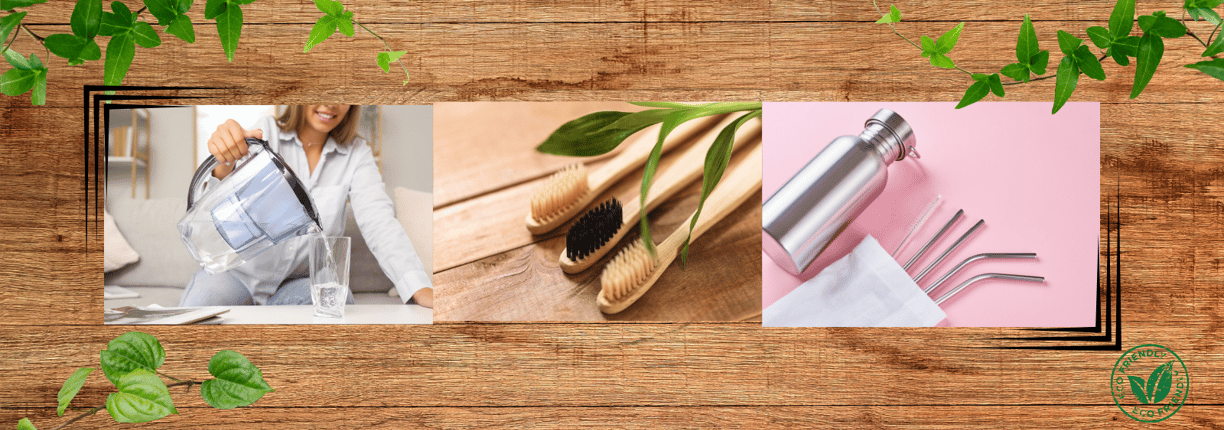

About our affiliate links...
Thank you for taking the time to explore these eco-friendly swaps and for visiting Conscious Ripple Living. We want you to know that 100% of the profits from all sales and commissions earned through these affiliate links go directly to supporting two incredible organizations: The Kigiri Children’s Organization and The Ssengooba Foundation Equality for Orphans Ministries in Uganda.
Five Budget-Friendly Swap Outs to Help the Planet Now
Making small, eco-conscious changes in your daily life doesn’t have to break the bank. Simple, budget-friendly swaps can have a big impact on the planet while improving your quality of life. It may not seem like you are doing much by just changing a few of your choices as a consumer, but collectively those choices add up and can cause significant positive change. From reducing plastic waste to minimizing your carbon footprint, here are five easy changes you can make today.
Stainless Steel Straws: The Durable and Eco-Friendly Choice
Plastic Straws as Ocean Pollutants
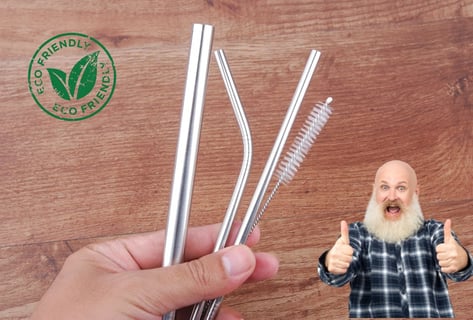

Do you love sipping your iced coffee or smoothie through a straw? Did you know that single-use plastic straws are among the top pollutants found in oceans, harming marine life and disrupting ecosystems? Additionally, these straws contribute to landfill overflow, where they take hundreds of years to degrade. Even worse, plastic straws break down into microplastics, contaminating soil and water systems and entering the food chain. To make matters worse, the production of plastic straws emits significant greenhouse gases, adding to climate change. Don’t worry—stainless steel straws are here to save the day! These durable and reusable alternatives are stylish, easy to clean, and can last for years. Plus, they’re recyclable when they eventually wear out.
Single-use plastic straws are a major contributor to ocean pollution. Each year, millions of these straws are improperly disposed of and find their way into waterways, where they harm marine life. Sea turtles, for instance, often mistake straws for food, leading to choking, injury, or even death. Straws also break down into smaller pieces called microplastics, which are ingested by fish and other marine creatures, contaminating the entire ocean food web. By eliminating plastic straws, we can take a significant step toward reducing the devastating impact of plastic pollution in our oceans.
Landfill Overflow and Slow Decomposition
Plastic straws contribute to the growing problem of landfill overflow. Due to their lightweight and small size, straws often slip through the sorting mechanisms at recycling facilities and end up in landfills. Once there, they can take up to 500 years to decompose, releasing harmful chemicals into the soil and groundwater. This prolonged degradation not only occupies valuable landfill space but also poses long-term risks to environmental health. Choosing reusable alternatives like stainless steel straws helps cut down on this unnecessary waste.
Microplastics in Soil and Water Systems
Another alarming consequence of plastic straws is the formation of microplastics. As straws slowly degrade, they fragment into tiny particles that contaminate soil and water systems. These microplastics are absorbed into the ground, threatening plant life and agricultural ecosystems. Furthermore, they infiltrate drinking water sources, raising serious health concerns for humans and animals alike. Switching to stainless steel straws is a proactive way to reduce the spread of microplastics and protect both the environment and public health.
Greenhouse Gas Emissions from Plastic Straw Production
The environmental impact of plastic straws begins long before they’re discarded. The manufacturing process relies on fossil fuels, releasing greenhouse gases that contribute to climate change. In contrast, while stainless steel straws also require energy to produce, their reusable nature makes them far less harmful over time. With proper care, a single stainless steel straw can replace hundreds, if not thousands, of disposable plastic ones, significantly lowering your carbon footprint.
Plastic straws may seem like a small convenience, but their environmental impact is anything but. From polluting our oceans and overloading landfills to contaminating ecosystems with microplastics and contributing to climate change, the consequences are far-reaching. However, by making a simple switch to stainless steel straws, you can play a role in reversing these
Our Conscious Ripple Living recommended choice—is this stainless steel straw set by DF Design that comes with a handy cleaning brush and pouch for carrying them on the go—makes this transition effortless. These straws are designed for use with reusable drink containers or cups so they are long enough to fit in even the deepest vessels. They also have a wider diameter so they are also perfect for smoothies, boba teas, or even milkshakes. Not only are these straws durable and stylish, but they’re also a meaningful step toward a healthier planet. Join the movement and make your conscious ripple today!
Here’s a statistic that’s hard to ignore: Every year, billions of single-use plastic bottles end up in landfills and waterways, contributing significantly to pollution and harming wildlife. Worse yet, the production of plastic bottles requires massive amounts of fossil fuels, increasing greenhouse gas emissions. Additionally, improper disposal of these bottles leads to microplastic contamination in soil, water, and food supplies. To top it off, the recycling rates for plastic bottles remain shockingly low, with most ending up as waste. But here’s the good news—switching to a reusable bottle is one of the simplest and most impactful ways to make a difference. Not only do they reduce plastic waste, but many are designed to keep your drinks hot or cold for hours.
Reusable Beverage Containers
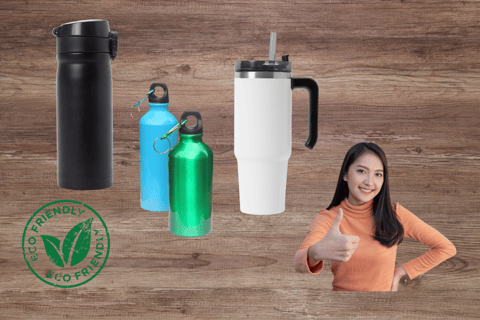

Environmental Impact of Single-Use Plastic Bottles
Single-use plastic bottles are a significant contributor to global pollution. Each year, over 8 million tons of plastic enter the oceans, with a large portion coming from discarded bottles. These plastics harm marine life, with fish, birds, and other animals ingesting or becoming entangled in the waste. Additionally, plastic bottles often end up in landfills, where they can take up to 450 years to decompose. Choosing reusable bottles eliminates the need for disposable plastics, helping to protect wildlife and reduce environmental damage.
High Carbon Footprint of Plastic Bottle Production
The environmental impact of plastic bottles begins before they’re even used. Producing a single-use plastic bottle requires significant amounts of petroleum and water, emitting greenhouse gases that contribute to climate change. In fact, it’s estimated that producing bottled water consumes three times the amount of water contained in the bottle itself. Switching to reusable bottles eliminates this ongoing demand, reducing your carbon footprint and conserving resources.
Low Recycling Rates for Plastic Bottles
In conclusion:
Benefits of Insulated and Reusable Bottles
Reusable bottles aren’t just eco-friendly—they’re also incredibly practical. High-quality insulated bottles keep beverages at their ideal temperature for hours. Whether you’re sipping hot coffee during a morning commute or enjoying ice-cold water on a hike, these bottles enhance your drinking experience. Many also come in a variety of designs and colors, allowing you to personalize your bottle while reducing your environmental footprint. Switching to a reusable bottle is a win-win for both you and the planet.
Our Conscious Ripple Living recommended choice—The Stanley Insulated Cup keeps beverages hot or cold for hours, making it perfect for on-the-go hydration. Its durable, eco-friendly design reduces your need for single-use containers while ensuring you always have your drink at the right temperature. Many customers love the wide variety of color choices. Extremely durable and easy to clean. There are even decorations and bling that you can purchase separately to personalize your cup. Keeps all your cold drinks cold and your hot drinks hot for exceptionally long periods of time. Great for gift giving!
The Case for Bamboo Toothbrushes: Sustainable Smiles
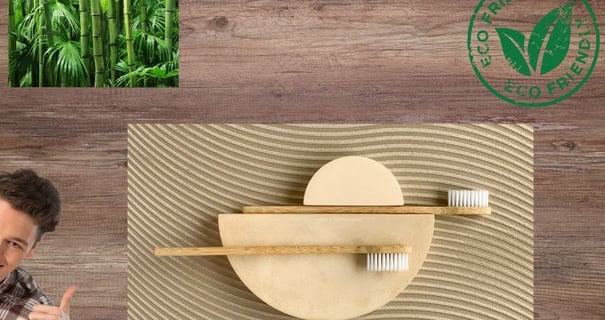

In conclusion:
Despite the emphasis on recycling, only 9% of all plastic ever produced has been recycled, with the majority either incinerated, dumped in landfills, or littered in the environment. Plastic bottles, in particular, often fail to be recycled due to contamination or lack of proper facilities. This inefficiency underscores the importance of reducing reliance on single-use plastics altogether. Reusable bottles provide a practical and stylish alternative, ensuring that less waste ends up in the environment.
The environmental toll of single-use plastic bottles is undeniable, from polluting oceans and leaching chemicals to contributing to climate change. But the solution is refreshingly simple: make the switch to a reusable bottle. Not only are reusable bottles an eco-friendly choice, but they also offer convenience, durability, and style.
Here’s a fact to consider: Over 1 billion plastic toothbrushes are thrown away each year in the U.S. alone, creating approximately 50 million pounds of waste annually. These toothbrushes, made from non-biodegradable plastic, take hundreds of years to decompose, piling up in landfills and contributing to the global plastic pollution crisis. Additionally, the production of plastic toothbrushes relies on fossil fuels, further increasing their environmental footprint. Worse yet, these plastics often break down into microplastics, contaminating soil, water, and even food supplies. But here’s the good news—switching to a bamboo toothbrush is a simple and effective way to reduce this impact. Bamboo toothbrushes are sustainable, biodegradable, and better for the planet while maintaining excellent oral hygiene.
Environmental Impact of Plastic Toothbrushes
Plastic toothbrushes are a significant contributor to global plastic pollution. With billions of them discarded annually, they make their way into landfills, oceans, and other natural environments, where they can take up to 500 years to degrade. In the process, these plastics break into microplastics, which are ingested by marine life and eventually enter the food chain, posing risks to both wildlife and human health. By choosing bamboo toothbrushes, you can minimize your contribution to this growing problem and help protect ecosystems from plastic waste.
The High Carbon Footprint of Plastic Toothbrush Production
The environmental cost of plastic toothbrushes begins long before they’re in your hands. Producing these toothbrushes requires petroleum, water, and energy, all of which contribute to greenhouse gas emissions and climate change. Unlike plastic, bamboo is a renewable resource that grows quickly and requires little water or fertilizer, making it an eco-friendly material. By switching to bamboo toothbrushes, you help reduce the demand for plastic manufacturing and its associated carbon emissions.
The Challenges of Recycling Plastic Toothbrushes
Recycling plastic toothbrushes is nearly impossible due to the combination of materials used, including plastic handles and nylon bristles. As a result, most end up as waste, either incinerated or discarded in landfills. Bamboo toothbrushes, on the other hand, are biodegradable. Once the nylon bristles are removed, the handle can be composted or repurposed, ensuring that less waste ends up polluting the planet
Benefits of Bamboo Toothbrushes
Bamboo toothbrushes aren’t just sustainable—they’re practical and hygienic. Bamboo naturally resists bacteria, making it an excellent choice for oral care. They’re lightweight, durable, and available in eco-friendly packaging, ensuring every aspect of your purchase aligns with a greener lifestyle. Plus, many bamboo toothbrushes come in multipacks, making them a cost-effective and convenient alternative to their plastic counterparts. Switching to a bamboo toothbrush is a small change that leads to a big impact, helping you contribute to a cleaner, healthier planet.
Our Conscious Ripple Living Recommended Choice—The VIVAGO Biodegradable Bamboo Toothbrush
The VIVAGO Biodegradable Bamboo Toothbrush is the perfect addition to your eco-conscious routine. Its biodegradable bamboo handle not only helps reduce plastic waste but also adds a touch of natural elegance to your bathroom. The soft nylon bristles are gentle on your gums while providing a thorough clean, making it an excellent choice for the whole family.
Many users appreciate the multipack option, ensuring you’re stocked up for months while staying budget-friendly. The toothbrush comes in plastic-free, recyclable packaging, so every detail aligns with sustainable living. It's lightweight, durable, and easy to use—everything you need in a toothbrush, with none of the environmental guilt.
Looking to personalize your routine? The sleek bamboo design is a canvas for your creativity, or simply enjoy its minimalist charm. These toothbrushes also make a thoughtful gift for anyone looking to adopt greener habits.

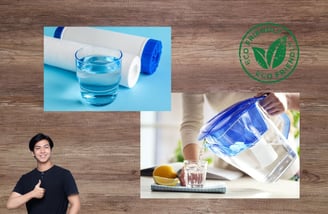
Filtering Your Water at Home
Filtering your water at home is one of the simplest and most impactful ways to reduce waste while ensuring you always have clean, refreshing water on hand. By cutting down reliance on single-use plastic bottles, you can significantly decrease your environmental footprint and help combat plastic pollution. Home filtration systems not only provide great-tasting water but also remove impurities, offering a healthier and more sustainable alternative to bottled water. With options ranging from countertop pitchers to under-sink systems, there’s a filtration solution for every household. Additionally, these systems are cost-effective and save money in the long run compared to frequently purchasing bottled water. By filtering your water at home, you’re making a conscious choice that benefits both the planet and your wallet....
Reducing Reliance on Plastic Bottles
Plastic water bottles are a leading source of pollution, with billions ending up in landfills and oceans every year. These bottles take hundreds of years to decompose and often break down into harmful microplastics that contaminate ecosystems. By filtering your water at home, you eliminate the need for single-use bottles, significantly reducing your plastic footprint. It’s a small lifestyle change with a big environmental payoff.
Clean, Great-Tasting Water
Filtered water not only tastes better but is also free of impurities like chlorine, sediment, and heavy metals. Many filtration systems are designed to rival the quality of bottled water, providing crisp, refreshing hydration with every pour. This makes it easier to transition away from bottled water while enjoying the added benefit of knowing exactly what’s in your glass.
Versatile Filtration Solutions
Home water filtration systems come in various forms to suit different needs. Countertop pitchers are affordable and convenient for smaller households, while faucet attachments offer continuous filtered water without taking up counter space. For larger families or avid water drinkers, under-sink systems provide an efficient, long-term solution. These options ensure there’s a setup for every lifestyle and home size.
Cost Savings Over Time
While bottled water may seem convenient, it’s also expensive and wasteful. Investing in a home filtration system is cost-effective in the long run, allowing you to enjoy unlimited clean water for a fraction of the price. Reusable filters often last for months, meaning fewer replacements and less waste compared to constantly buying and disposing of bottles.
Closing Thoughts on Filtering Water at Home
Filtering your water at home is a practical, eco-friendly choice that offers numerous benefits. By reducing your reliance on single-use plastic bottles, you’re cutting down on waste and pollution. Home filtration systems provide great-tasting, impurity-free water, ensuring your family stays hydrated without the environmental guilt. With options to suit every household and budget, you can find the perfect solution to fit your needs while saving money in the long term.
By choosing a home water filtration system, you’re making a small but impactful step toward a more sustainable and conscious lifestyle.
Our Concious Ripple Living recommended choice: The Brita UltraMax Filtered Water Dispenser
The Brita UltraMax Filtered Water Dispenser is a fantastic option for families. It’s affordable, holds 18 cups, and eliminates the need for plastic water bottles. Plus, it fits neatly in your fridge or on your countertop. Check out the link in the notes if you’d like to learn more and start filtering your water today!
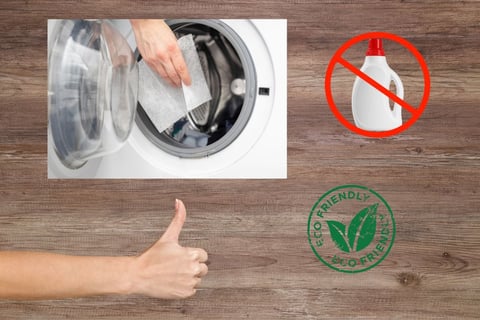

Dissolvable Laundry Detergent Sheets
Did you know that most liquid laundry detergents come in large plastic bottles, contributing significantly to waste and pollution? Each year, millions of these bottles end up in landfills or the ocean, where they take centuries to decompose. Dissolvable laundry detergent sheets offer a revolutionary, eco-friendly alternative. These compact sheets are plastic-free, lightweight, and just as effective as traditional detergents. Beyond their environmental benefits, they simplify laundry routines and are perfect for both home use and travel.
By switching to dissolvable detergent sheets, you’re making a conscious choice to reduce plastic waste while maintaining a clean, efficient laundry experience.
Reducing Plastic Waste
Traditional liquid detergents are packaged in bulky plastic bottles, which contribute to the growing plastic waste problem. Despite recycling efforts, a significant portion of these bottles ends up in landfills or polluting waterways. Dissolvable detergent sheets eliminate the need for plastic altogether. Packaged in minimal, recyclable materials, they offer a sustainable solution that aligns with the growing demand for zero-waste products.
Lightweight and Convenient
Unlike liquid detergents, which are heavy and prone to spills, detergent sheets are lightweight and mess-free. Their compact design makes them easy to store, saving valuable space in your laundry area. They’re also incredibly convenient for travel—just slip a few sheets into your bag, and you’re set for fresh, clean clothes wherever you go. This makes them an ideal choice for anyone looking to simplify their laundry routine without compromising on quality.
Effective and Gentle Cleaning
Dissolvable laundry sheets are just as effective as traditional detergents, offering powerful stain removal and a fresh clean for all types of fabrics. Many brands, like The Laundry Club, use plant-based formulas that are free from harsh chemicals, making them safe for sensitive skin and environmentally friendly. These sheets dissolve quickly in both hot and cold water, ensuring your clothes are thoroughly cleaned with minimal environmental impact.
Perfect for a Sustainable Lifestyle
Dissolvable laundry detergent sheets are a small but impactful way to embrace a more eco-conscious lifestyle. They not only reduce plastic waste but also minimize water consumption during production compared to liquid detergents. For individuals and families aiming to reduce their ecological footprint, detergent sheets are a simple yet transformative choice that aligns with sustainable living goals.
Conclusion:
Switching to dissolvable laundry detergent sheets is an easy and effective way to make your laundry routine more eco-friendly. By reducing plastic waste, simplifying storage, and delivering powerful cleaning performance, these sheets provide a sustainable alternative to traditional detergents. Whether you’re looking for a better travel solution or just want to cut back on waste, detergent sheets are a game-changer for a greener lifestyle.
Our Conscious Ripple Living recommended choice is the Laundry Detergent Sheets by The Laundry Club.
Made with plant-based ingredients, they’re gentle on sensitive skin and come in minimal, recyclable packaging. Lightweight and compact, they’re perfect for both home use and travel. Check out the link in the show notes to try them today and start transforming your laundry routine!.
Wrapping it all up...
Making these five swaps—reusable straws, water bottles, bamboo toothbrushes, home water filtration, and dissolvable laundry detergent sheets—are practical, budget-friendly steps toward a more sustainable future. Each of these changes may seem small, but together they create a ripple effect, inspiring others and contributing to a healthier planet.
Start with one swap or try them all; either way, you’re taking meaningful action toward conscious living. Together, we can build a world where sustainability is simple, accessible, and impactful.
